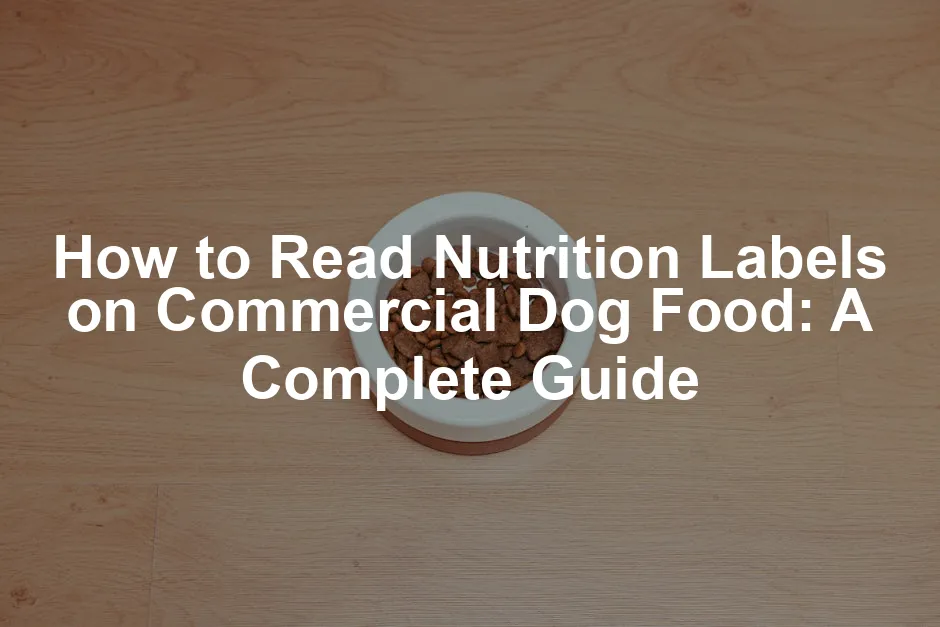Introduction
Understanding dog food labels can feel like reading hieroglyphics for many pet owners. With an avalanche of brands, flavors, and claims, how can you ensure that you’re feeding Fido the best? In a world where “natural” and “organic” sound appealing but can be misleading, it’s essential to decode the jargon and make informed choices. This guide will transform you from a confused consumer into a savvy shopper, ready to navigate the pet food aisle with confidence. Let’s unleash the secrets behind nutrition labels and set your pup on the path to a healthy, balanced diet!
When you walk down the pet food aisle, it’s easy to get lost. Is it chicken, beef, or fish that’s best? What’s up with all those fancy terms? Well, you’re not alone! Many dog owners are perplexed by the myriad options. But fear not! Understanding these labels is not rocket science—it just takes a bit of know-how.
First, let’s talk about the big headline: the product name. This will give you clues about what your dog is really eating. Next, you’ll want to analyze the ingredient list. Ingredients are listed by weight, so pay attention to what’s at the top. Spoiler alert: If it’s corn, you might want to reconsider your choices! Consider opting for something like Blue Buffalo Life Protection Formula Adult Dog Food—a great choice that provides essential nutrients for your furry friend!
The guaranteed analysis is another crucial piece of the puzzle. It tells you the minimums and maximums of key nutrients. This info can help you compare different foods like a pro! And then, there’s the nutritional adequacy statement—your ticket to ensuring your dog is getting a balanced diet.
So, grab your reading glasses and let’s break it down together. By the end of this guide, you’ll be equipped with all the knowledge you need to make the best choices for your furry friend.

Summary of Key Points
In this article, we’ll explore the various components of dog food labels to empower you as a pet parent. You’ll learn about the importance of the guaranteed analysis, which reveals the nutritional breakdown of the food, and how to interpret the ingredient list, where quality matters more than quantity. We’ll also discuss the nutritional adequacy statement, a crucial marker that confirms whether the food meets AAFCO standards for your dog’s life stage. Additionally, we’ll touch on common claims and terms you may encounter, such as “grain-free,” “natural,” and “by-products.”
By the end, you’ll have a cheat sheet to help you read labels quickly and efficiently, ensuring your furry friend gets the nutrition they deserve. No more guessing games when it comes to your pup’s food! You’ll know what to look for and what to avoid.
Remember, a well-fed dog is a happy dog. And with the right knowledge, you can confidently select a food that not only meets their nutritional needs but also supports their overall well-being. For instance, Royal Canin Size Health Nutrition Small Adult Formula is another excellent option that caters specifically to small breeds!

The Format of Dog Food Labels
Understanding dog food labels begins with recognizing their standard format. All commercial pet food labels must adhere to specific guidelines set by regulatory bodies like AAFCO. The typical layout includes several essential components.
First, you’ll find the product name, which often hints at the primary ingredient. Next is the quantity, indicating how much food is in the package, whether measured by weight, liquid volume, or count.
Then comes the guaranteed analysis section, detailing the minimum levels of protein, fat, and fiber, along with maximum moisture content. This is crucial for assessing a food’s nutritional value. If you want a high-quality option, consider Hill’s Science Diet Adult Dog Food, which is known for its balanced nutrition!
The ingredient list follows, where ingredients are listed in descending order by weight. This means the first ingredient is what constitutes the bulk of the food, so pay close attention!
Next, the nutritional adequacy statement ensures that the food meets AAFCO guidelines for complete nutrition tailored to your dog’s life stage.
Feeding directions are also included, offering guidelines on how much food to serve based on your dog’s size and age. Lastly, you’ll find manufacturer information and often a calorie statement, helping you understand how much energy your pup is getting.

Key Components of Dog Food Labels
Product Name
The product name is your first clue about what’s inside. It typically emphasizes the main ingredient. For instance, “Chicken Dog Food” means chicken is the star of the show, comprising at least 95% of the total weight, excluding water. The 95% rule ensures that when you see a name like this, you can trust it’s primarily made of that ingredient.
However, if the name contains terms like “dinner” or “formula,” it only needs to contain 25% of the named ingredient. And if it says “with chicken,” that means just 3% is needed. This labeling strategy can sometimes mislead pet owners, so be sure to read closely!

Guaranteed Analysis
The guaranteed analysis is a treasure trove of nutritional information. It lists the minimum percentages of crucial nutrients: protein, fat, fiber, and moisture. Understanding these values is vital for assessing your dog’s dietary needs.
It’s essential to interpret these percentages on a dry matter basis. This means removing moisture content from wet foods to accurately compare them with dry kibble. For instance, a food might have 25% protein when wet, but when dry, it could be significantly higher! So, keep your calculator handy and do the math for an informed choice. If you’re looking for a reliable dry option, check out Purina Pro Plan Savor Adult Dry Dog Food, which is formulated to meet those needs!

Ingredient List
The ingredient list can reveal much about the quality of a dog food. Ingredients are listed by weight, so the first few items are the most significant. If you see whole meats at the top, that’s a good sign! However, don’t be fooled by the water content in whole meats, which can mask lower-quality fillers.
Whole meats are preferable to meat meals, which are concentrated sources of protein. Be cautious of by-products and fillers, like corn or soy, which may not provide the best nutrition. Look for high-quality ingredients like named meat sources, vegetables, and grains. If you’re interested in a grain-free option, Wellness CORE Grain-Free Original Deboned Turkey Recipe is a superb choice!
Also, watch for ingredient splitting, where manufacturers list various forms of the same ingredient to make it seem less significant. For example, if you see “corn meal” and “corn gluten meal,” they can add up to a hefty portion while hiding the meat content.

Nutritional Adequacy Statement
The nutritional adequacy statement is your assurance that the food meets established nutritional standards. It indicates whether the food is suitable for specific life stages—puppy, adult, or senior.
This statement often cites AAFCO guidelines, ensuring the food provides a balanced diet for its intended purpose. If a food is labeled as “complete and balanced,” it meets all necessary nutrient levels required for your dog’s health.
You might see two types of claims here: one based on formulation, meaning the ingredients are designed to meet nutrient profiles, and the other based on feeding trials, which confirms the food has been tested on live animals.
This distinction is vital. If a product lacks this statement, it might not provide adequate nutrition, or it may only be suitable as a treat or supplement. So, ensure that your dog’s food has this seal of approval!
By understanding these key components, pet owners can navigate the pet food aisle with confidence and provide their furry friends with the nutrition they deserve.

What is the Nutritional Adequacy Statement?
The Nutritional Adequacy Statement is your dog food’s license to thrive! It shows whether a food meets the standards set by the Association of American Feed Control Officials (AAFCO). This means the food is not just a pretty package—it has passed tests to confirm it provides a balanced diet for your pup.
This statement can be found on the back or side of the package, often in fine print. Look for phrases like “complete and balanced” or “formulated to meet AAFCO standards.” These phrases guarantee that the food contains the required nutrients for different life stages.
Speaking of life stages, the statement breaks it down further. You’ll see claims like “for puppies,” “adult maintenance,” or “senior dogs.” Each life stage has different nutritional needs. Puppies need more energy and growth nutrients, while seniors may require fewer calories and added joint support. Always choose a food that matches your dog’s current life stage for optimal health!

Importance of Nutritional Adequacy
The Nutritional Adequacy Statement is critical for your dog’s health. If the food claims to be “complete and balanced,” it means it meets all the essential nutrient needs for your dog’s specific life stage. This ensures your furry friend gets everything they need to thrive, from protein to vitamins and minerals.
But what’s the difference between “complete and balanced” and “intermittent or supplemental”? The former means that the food is suitable as a full-time diet. The latter implies that the food should only be given as a treat or a small part of their diet, not as their main source of nutrition. Always check this statement to avoid potential health problems from inadequate nutrition! So, when you’re picking out Fido’s kibble, let the Nutritional Adequacy Statement guide you to a healthier, happier pup.

Decoding Common Dog Food Terms
Natural and Organic
What do “natural” and “organic” really mean? These terms sound great but can be a bit of a riddle. “Natural” generally means no artificial ingredients. However, it lacks strict regulatory oversight, so it can be a bit of a free-for-all. “Organic” refers to ingredients grown without synthetic fertilizers or pesticides, but there’s no official definition for pet food. So, what should you do? Always check the source of these ingredients. Just because a label says “natural” or “organic” doesn’t mean it’s high quality. Dig a little deeper!

Grain-Free and High-Protein Claims
Grain-free diets are trending, but the veterinary community has mixed feelings. Some studies link grain-free diets to heart issues in certain breeds. So, if you’re considering going grain-free, consult your vet first! If you want to try a grain-free dog food, Taste of the Wild High Prairie Canine Recipe is a fantastic option!
Now, onto protein. High-protein claims can be enticing, but it’s essential to consider the source. Look for named proteins like chicken or beef. Exotic proteins like bison or kangaroo can be great for dogs with sensitivities. But be cautious about by-products; they can vary widely in quality. Always prioritize clarity in labeling to keep your furry friend safe and sound!

Other Descriptive Terms
When wading through the sea of dog food labels, you might encounter terms like “lite,” “low-calorie,” and “human-grade.” But what do they really mean? Let’s break them down!
“Lite” often indicates a product with reduced calories compared to standard formulas. However, the magic number for what qualifies as “lite” can vary from brand to brand. So, always check the fine print to see how much lighter it is!
“Low-calorie” typically means the food has fewer calories than regular dog food, which can be beneficial for weight management. Yet, don’t be fooled! A “low-calorie” tag doesn’t always guarantee a nutritious meal. Quality matters just as much!
Now, let’s talk about “human-grade.” This term claims that all ingredients are fit for human consumption. Sounds fancy, right? But it’s worth knowing that this label doesn’t always ensure that the food is safer or more nutritious than standard pet food. Always look for more than just a catchy label!
Beware of marketing language! Terms like these can be misleading. They might make the food sound healthier than it is. Don’t let the jargon sway you. Instead, focus on the actual ingredients and nutritional content to make informed choices for your furry friend.

Quick Checklist for Reading Dog Food Labels
Ready to conquer the pet food aisle? Here’s a handy checklist to ensure you’re picking the best grub for your pup!
- First Ingredient: Always make sure the first ingredient is a named meat. This tells you that your dog’s food is primarily protein-based, which is essential for their health.
- Nutritional Adequacy Statement: Look for this crucial seal, which confirms the food meets AAFCO standards for complete and balanced nutrition. It’s your assurance that the food is appropriate for your dog’s life stage.
- Feeding Guidelines: Check for clear instructions on how much to feed your dog. These guidelines are a great starting point, but adjust based on your dog’s activity level and weight.
- Marketing Jargon: Keep an eye out for terms that sound fancy but don’t mean much, like “premium” or “holistic.” These terms are often just marketing fluff!
- Filler Ingredients: Avoid foods that list fillers like corn, wheat, or soy high in the ingredient list. These can provide little nutritional value and may lead to weight gain.
- Quality of Ingredients: Pay attention to the quality of ingredients. Whole meats and identifiable sources of protein should be at the top of the list.
- Check for By-Products: While some by-products can be nutritious, knowing the source is key. Be cautious and choose brands that are transparent about their ingredients.
- Expiration Date: Always check for a sell-by or expiration date to ensure freshness. Your dog deserves the best, so don’t feed them stale kibble!

Conclusion
Understanding how to read dog food labels is crucial in ensuring your pet receives proper nutrition. Armed with the knowledge from this guide, you can confidently choose a diet that meets your dog’s needs, taking into account their age, breed, and health conditions.
The right food will not only satisfy their hunger but also contribute to their overall well-being. Remember, when it comes to our furry companions, informed decisions lead to happy, healthy lives. Consider investing in a PetFusion Ultimate Dog Bed for your pup to rest comfortably!
So next time you stroll down that pet food aisle, you’ll strut with confidence, knowing exactly what to look for on those baffling labels. Trust your instincts, and your dog will thrive on the nutrition they deserve!

FAQs
What should I look for in a dog food ingredient list?
When examining a dog food ingredient list, prioritize whole meats, vegetables, and grains. Whole meats like chicken or beef should lead the list, indicating high protein content. Vegetables add essential nutrients and fiber, while grains can provide energy and support digestion. Steer clear of vague terms like “meat by-products” or “animal meal,” as these can mask lower-quality ingredients. Fillers such as corn or soy offer minimal nutritional value. Always look for specific ingredient names to ensure quality and transparency.
How often should I change my dog’s food?
Changing your dog’s food isn’t a frequent necessity. It largely depends on your pup’s specific needs, age, and any health conditions. Frequent changes can upset your dog’s stomach, leading to digestive issues. If you notice signs of allergies or sensitivities, consult your veterinarian. If a change is warranted, do it gradually over several days to allow your dog’s digestive system to adjust. A consistent diet usually keeps your furry friend happy and healthy.
Are by-products bad for my dog?
Not necessarily! By-products can be nutrient-rich ingredients, like liver, which is packed with vitamins. However, it’s essential to know their sources. Quality varies widely, so look for specific by-product names rather than vague terms. A reputable brand will be transparent about where these by-products come from. If you prefer to avoid them altogether, choose foods that clearly list whole meats and named ingredients.
How can I assess dog food quality?
Assessing dog food quality involves a few key factors. Look for transparency in labeling—brands that clearly list their ingredients and sourcing generally prioritize quality. High-quality ingredients, like whole meats, fresh vegetables, and grains, should be at the forefront. Additionally, reputable brands often undergo feeding trials and have nutritional adequacy statements confirming they meet AAFCO standards. Researching the brand’s reputation and reading reviews can also guide your decision.
What if my dog has food allergies?
If your dog has food allergies, consulting your veterinarian is essential for personalized feeding options. They may recommend hypoallergenic diets or limited-ingredient foods that minimize allergens. Keep an eye out for common allergens like beef, chicken, dairy, or grains. A gradual transition to a new food can help monitor any reactions. Always read labels carefully and select foods specifically formulated for dogs with dietary sensitivities to ensure your pup stays healthy and happy.
Please let us know what you think about our content by leaving a comment down below!
Thank you for reading till here 🙂
All images from Pexels





